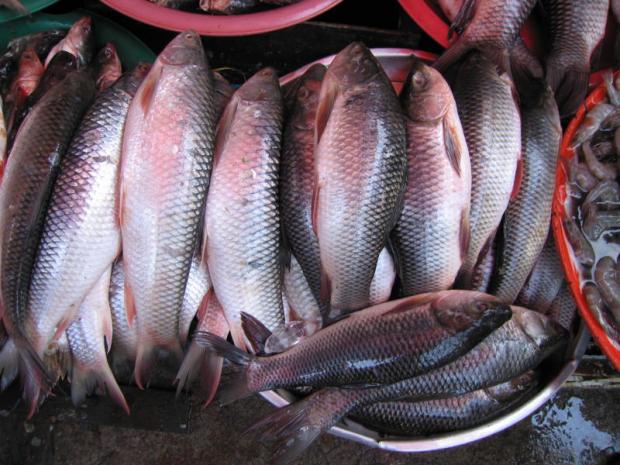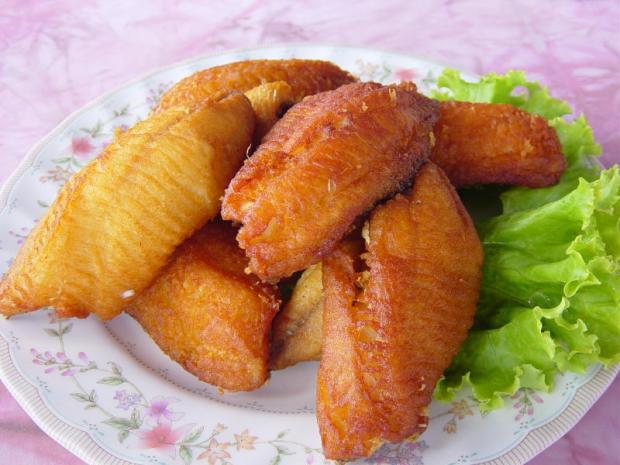Thais are experts when it comes to eating fish. This has to do with people's lifestyle since the old days, as their lives have always intertwined with rivers and canals. A variety of fish is easy to find. People don't even have to buy them because they can catch fish themselves. From experience, people soon learn distinctive qualities about each fish and what sort of food should be made from it, including how to season it and what kind of vegetables would go with it. Another mindset is to not let the fish go to waste. If a lot of fish are caught, they can be preserved to eat later.
Before, rural dwellers used to stick their fishing rods along the dock in front of their house. Some went out on a boat and cast their net. With these methods, people can never know what sort or size of fish they'll get. Anyhow, they don't throw away small ones, as those can be made into pla ra (fermented fish). Small fish can also be scaled, chopped and rolled into fish balls, with spicy curry and coconut milk. This is called gaeng sub nok. There may be some fine pieces of fishbone, but it's better than throwing the fish away.
Pla krai (clown featherback) are difficult to find. They are most suitable for fishcakes. Their belly and the flesh along the lower fin are especially fatty. They are usually mixed with salt and deep-fried. For dipping sauce, mix cucumber, cayenne, shallot, salt, sugar and vinegar.

Local fish in Uthai Thani include silver barb and giant gourami. Suthon Sukphisit
Pla khao (sheatfish) have no scales. They look like swai but their body is longer. Pla khao can be deep-fried or made into tom yum or spicy curry with fermented bamboo shoot. If fresh bamboo shoot is found, it can be boiled with pla ra, fish, palm sugar and kaffir lime leaves to make gaeng tom pur.
Pla krathing (tire-track eel) has a long body with a scale pattern similar to that of a python. Despite its unappealing appearance, it's desired for food. Before being cooked, pla krathing is grilled with coconut shell for the flesh to be dry and fragrant. They are then torn into long strips and put in spicy curry, or tom yum with tamarind juice, or fried with dried chilli. They're all delicacies.
That was when people were still catching their own fish. They cooked according to the type of fish and used every part wisely whether from big or small fish.

Jullien's golden carp. Suthon Sukphisit
Most Thais no longer live by the river, nor do they have any bond with this kind of lifestyle. In Bangkok, especially, the water quality is low. It's dirty. People in general wouldn't eat fish caught from within Bangkok's waters. As the population has also increased, relying on fish from natural sources alone isn't enough. So, fish from commercial farms came to be in our fresh market. Bangkokians are generally familiar with snakehead fish, catfish, featherback, snakeskin gourami, silver barb, black and white tilapia, and red tilapia.
But in rural areas, there remain local fish that people in the neighbourhood catch and sell at market. If Bangkokians were to visit the area, they wouldn't know these local fish or what dishes can be made from them. The way people sell these fish may not look too inviting, as they simply put them in a water basin or aluminium tray low on the ground. They rarely lay out the fish on ice.
In Uthai Thani, Chai Nat, Sing Buri and Ang Thong, for example, local fresh markets often have a selection of strange fish for city dwellers, such as twisted-jaw catfish, giant barb, Jullien's golden carp, Boeseman croaker, naked catfish, tire track eel, goby, giant gourami, and lipped barb with red fin.

Fried Mozambique tilapia, above, and fried sundried Mozambique tilapia, right. Suthon Sukphisit
These fish are of good quality with great flesh, each suitable for certain kinds of food. For instance, naked catfish are best for spicy curry, Boeseman croakers for tom yum, twisted-jaw catfish for deep-frying or curry, and lipped barbs for deep-frying. These are among the fish from rivers and canals.
There are also those living in brackish water, along the river mouth with some saltiness in it. This includes areas in Samut Sakhon, Samut Songkhram and Samut Prakan. These areas also have lots of mangroves, where many fish and molluscs live.
There are many kinds of fishes living in brackish water, such as eeltail catfish, flathead mullet, barramundi, blue threadfin and eagle ray (a small ray that can jump a distance from water). Each fish is suitable for different dishes. Eeltail catfish is good for jungle curry and spicy stir-fry. Flathead mullet and blue threadfin are good for som tam (with curry paste made from shallot, pepper, ginger and spring onion), and eagle ray is best to dry and deep-fry.
Among the fish in the brackish water in Klong Yi Sarn, Samut Songkhram, Klong Yai Li and Klong Suppasamitr in tambon Laem Fapha in Samut Prakan, there are lots of Mozambique tilapia that are smaller and have harder flesh than other tilapia, though many prefer that over other types of tilapia. They are usually soaked in salt or fish sauce, and sun-dried they are delicious and cheap.
This is a story of fish from the past -- when fish could be found in abundance.

